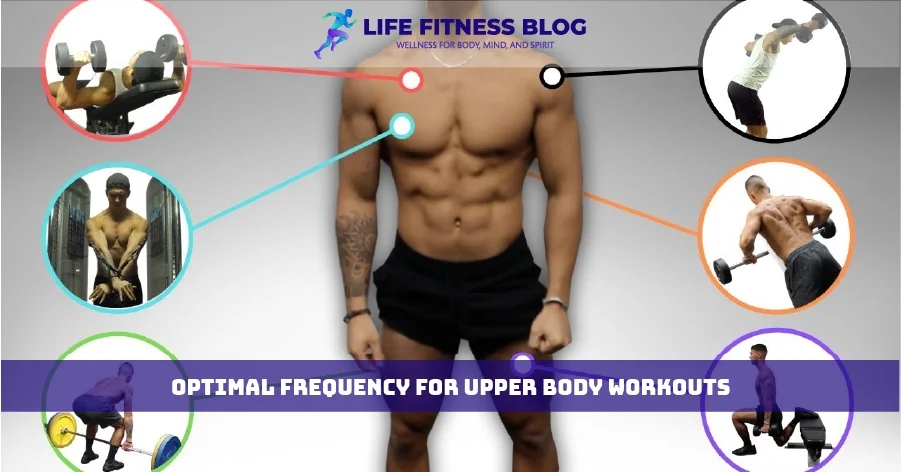Many people want a strong and toned upper body. But, figuring out how often to work out is key. Whether you want to build muscle, get stronger, or boost your upper body fitness, finding the right balance is important.
How often you work out your upper body affects muscle growth, strength, and fitness. It’s vital to challenge your muscles and give them time to recover and repair. This balance makes your workouts more effective.
Table of Contents
Understanding Upper Body Training Fundamentals
To create a great upper body workout, you need to know the muscles involved and how to recover and grow them. Learning these basics helps you get the most out of your arm exercises, chest workouts, back workouts, and shoulder workouts.
Muscle Groups Involved in Upper Body Training
The upper body has many muscles, like the chest, shoulders, back, biceps, and triceps. Each muscle is important for strength, stability, and sports performance.
Basic Principles of Muscle Recovery
Muscle growth and repair are key to a good upper body workout. You need the right food, enough sleep, and active recovery to let your muscles heal and get stronger.
Role of Progressive Overload
Progressive overload is vital for building muscle and strength. By making your workouts harder over time, you challenge your muscles to grow and adapt.
Understanding these basics lets you create a workout plan that works well and lasts. It helps you reach your fitness goals with confidence and skill.
Optimal Frequency for Upper Body Workouts
Finding the best frequency for upper body workouts is key. The right schedule depends on your fitness level, how well you recover, and your goals. Let’s look at the science to find the perfect balance for your training.
Beginner Lifters
Start with 2-3 upper body workouts per week if you’re new to strength training. This lets your muscles recover and grow. As you get better, you can do more and harder workouts.
Intermediate and Advanced Lifters
For those who are more experienced, 3-4 upper body sessions per week can help build muscle and strength. This schedule lets you focus on different muscle groups more often. But remember to listen to your body and adjust if needed.
Factors to Consider
- Your overall training load and recovery status
- The intensity and volume of your upper body workouts
- The specific exercises and muscle groups you’re targeting
- Your individual response to training and recovery
What’s best for you will depend on your unique situation. Try different schedules, watch how your body responds, and adjust as needed. This will help you find the best routine for you.
| Fitness Level | Recommended Upper Body Workout Frequency |
|---|---|
| Beginner | 2-3 times per week |
| Intermediate/Advanced | 3-4 times per week |
“The key to maximizing upper body gains is finding the right balance between training stimulus and recovery.”

Signs You’re Training Your Upper Body Too Much
Training your upper body too much can cause many problems. You might see physical signs, notice your performance drop, or struggle with recovery. It’s key to spot these signs early to avoid more harm and give your muscles time to heal and get stronger.
Physical Indicators of Overtraining
- Persistent muscle soreness or pain that does not subside with rest
- Unexplained weight loss or inability to gain muscle mass despite consistent strength training
- Decreased range of motion or joint stiffness in the shoulders, elbows, or wrists
Performance-Related Warning Signs
- Inability to lift the same weights or complete the same number of reps as before
- Decreased power and explosiveness during exercises like push-ups or pull-ups
- Feeling fatigued or exhausted during your workouts, even with adequate rest
Recovery-Based Symptoms
Overtraining can slow down muscle recovery, mess with your sleep, and make you more prone to getting sick or hurt. You might see:
- Difficulty falling asleep or staying asleep
- Frequent colds, flu, or other infections
- Prolonged feelings of muscle fatigue or weakness
If you see any of these signs, it’s time to change how often and how hard you train. This will help your muscles recover and rebuild. It keeps you from overdoing it and lets you keep improving your upper body strength.
Designing Your Weekly Upper Body Training Split
Creating a good upper body training plan is key to reaching your fitness goals. Your weekly gym schedule should balance muscle challenge and recovery time. A well-thought-out upper body training split helps you get the most from your workouts and see steady progress.
Think about your fitness level and experience. Beginners might start with 2 or 3 upper body workouts a week. This lets their muscles adjust. As you get more experienced, you can increase workout frequency to fit your goals and body.
- Check your current workout plan: See how upper body training fits into your overall routine.
- Figure out your workout frequency: Aim for 2-4 upper body sessions a week, based on your experience and recovery.
- Balance push and pull exercises: Make sure your routine includes both to develop muscles evenly.
- Include rest and recovery: Add rest days and active recovery to help muscles heal and grow.
- Adjust as needed: Keep an eye on your progress and tweak your routine to improve your fitness.
By designing a good weekly upper body training split, you can tailor your fitness routine and gym schedule to your needs. This ensures you get the right upper body workout frequency for the best results.

How Often Should You Do Upper Body Workouts?
Building muscle and strength depends on how often you work out your upper body. The best schedule varies on your experience, how well you recover, and your fitness goals.
Factors Affecting Training Frequency
Several factors influence how often you should work out your upper body:
- Your current fitness level and muscle-building experience
- The intensity and volume of your workouts
- Your body’s recovery and adaptation rate
- Your specific muscle-building or strength-training objectives
Adjusting Frequency Based on Experience Level
Here’s a general guideline:
- Beginners should train their upper body 2-3 times a week for good recovery and adaptation.
- Intermediate lifters can usually do 3-4 upper body sessions a week, as long as they control their workout volume and intensity.
- Advanced trainees might be able to work out their upper body 4-5 times a week. But they need to watch out for overtraining and make sure they get enough rest.
Recovery Requirements
No matter your experience, listening to your body and giving it time to recover is key. Sleep, nutrition, and managing stress all help your body recover and adapt to workouts.
By understanding what affects upper body workout frequency and adjusting your plan, you can improve your muscle building and strength. This way, you avoid overtraining and injuries.
Balancing Push and Pull Exercises
It’s important to have a balanced workout routine for your upper body. This means doing exercises that work your chest, shoulders, and triceps, and also your back and biceps. Mixing both types of exercises helps your muscles grow evenly and prevents injuries.
To balance your workouts, plan your week with equal push and pull days. For example, spend two days on exercises like chest workouts and shoulder workouts. Then, dedicate two days to back workouts and arm exercises. This way, all muscle groups get the attention they need.
| Push Exercises | Pull Exercises |
|---|---|
| Bench Press | Lat Pulldown |
| Overhead Press | Seated Row |
| Triceps Pushdown | Biceps Curl |
| Push-ups | Bent-over Row |
By mixing push and pull exercises, you ensure your muscles grow evenly. This balanced approach helps you avoid imbalances and injuries. A well-rounded upper body workout is key to reaching your fitness goals and looking good.
Upper Body Recovery Strategies
Keeping a balanced fitness routine is crucial for muscle recovery. It helps you get the most out of your upper body workouts. By using the right recovery methods, you can help your muscles grow and avoid overtraining.
Nutrition for Muscle Recovery
Good nutrition is key for muscle recovery. Eat foods high in protein, complex carbs, and healthy fats. This gives your body what it needs to fix and grow muscles. Focus on lean proteins, whole grains, fruits, and veggies to help your body recover.
Sleep and Rest Importance
Getting enough sleep and rest is vital for muscle recovery. Aim for 7-9 hours of sleep each night. This lets your body fix and build muscle. Try to sleep at the same time every night and make your sleep area comfy for better rest.
Active Recovery Methods
Active recovery can really help your muscles after working out. Try light cardio, gentle stretching, or yoga. These activities boost blood flow, lessen soreness, and aid in healing. Do these on your rest days to help your fitness routine.
Focus on good nutrition, quality sleep, and active recovery. This will help your muscles recover well and keep you moving forward in your upper body workouts.

Common Upper Body Training Mistakes
To get a strong upper body, you need to train right and be dedicated. But, many people make mistakes that slow down their progress. Let’s look at some common errors and how to steer clear of them.
One big mistake is overtraining certain muscle groups like the chest or arms. But ignoring the back or shoulders is a problem too. This can cause muscle imbalances and less-than-ideal results. Make sure your workout covers all major muscle groups evenly.
- Make sure your routine includes a mix of arm exercises, chest workouts, back workouts, and shoulder workouts. This helps you look balanced and symmetrical.
- Don’t overdo your favorite exercises, like bicep curls or bench presses. Other exercises are important too.
Another mistake is using improper form during workouts. Bad form can make your workout less effective and risk injury. Always focus on your technique. If you’re unsure, ask a personal trainer or someone experienced at the gym for help.
“Proper form is the foundation for building strength and muscle. Never sacrifice technique for heavier weights.”
Lastly, many people don’t give their muscles enough recovery and rest after working out. Too much training can cause burnout, lower performance, and injuries. Make sure to give your muscles time to heal and grow by resting enough between workouts.
- Change how often you work out based on your level and how fast you recover.
- Use active recovery methods, like light cardio or stretching, to help your muscles heal and prevent injuries.
By avoiding these common mistakes, you’ll be on your way to a strong, balanced, and attractive upper body.
Maximizing Results with Proper Training Volume
To reach your muscle-building and strength goals, finding the right workout volume is key. Knowing the best sets and reps, and choosing the right exercises, can boost your upper body. This will help you reach new heights in your training.
Sets and Reps Guidelines
For upper body workouts, 8-12 reps per set is best for muscle growth. Lower reps, 4-6, are better for strength. Do 3-5 sets for each exercise, adjusting based on your level and recovery.
Exercise Selection Tips
Picking the right exercises is crucial for your upper body routine. Choose compound movements like bench presses, pull-ups, and overhead presses. They work many muscles at once. Add isolation exercises to target any weak areas.
Conclusion
The frequency of your upper body workouts depends on your fitness goals, experience level, and recovery capacity. While daily workouts might be possible for some, it’s generally recommended to allow for adequate rest and recovery between sessions.
By understanding your body’s needs, tailoring your training routine, and implementing proper recovery strategies, you can optimize your upper body workouts and achieve your fitness goals.
Also Read:
FAQs
Is it okay to train my upper body every day?
While daily upper body training is possible, it’s important to listen to your body and adjust your routine accordingly. Overtraining can lead to injuries and hinder progress.
How can I prevent overtraining when training my upper body frequently?
Prioritize rest, nutrition, and hydration. Incorporate active recovery methods like yoga or light cardio. Listen to your body and adjust your workout intensity and volume as needed.
What are some effective exercises for building upper body strength?
Compound exercises like bench press, pull-ups, rows, and overhead press are excellent for building overall upper body strength. Isolation exercises like bicep curls and tricep extensions can target specific muscle groups.
How long should I rest between sets during my upper body workout?
The optimal rest period depends on the intensity of your workout and your fitness level. Generally, 1-2 minutes of rest between sets is sufficient for most people.
What are some tips for improving upper body muscle recovery?
Prioritize sleep, eat a balanced diet rich in protein, and stay hydrated. Incorporate foam rolling or massage therapy to release muscle tension. Listen to your body and adjust your training schedule as needed.




